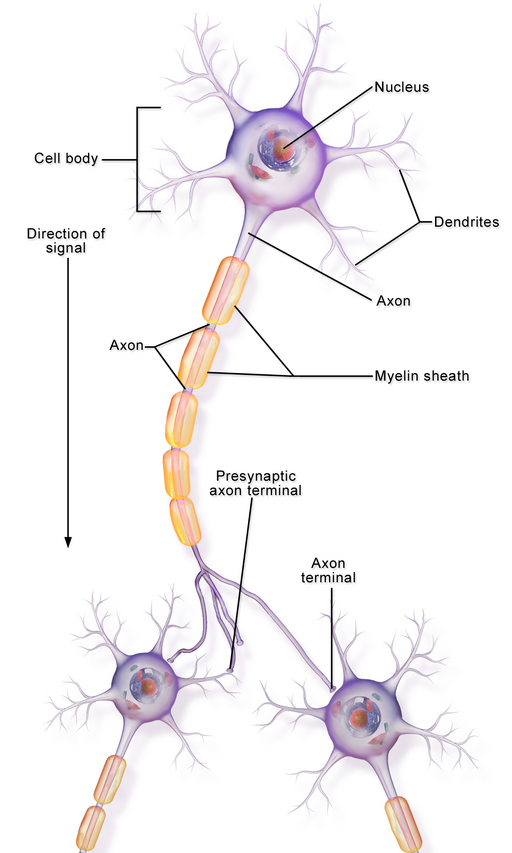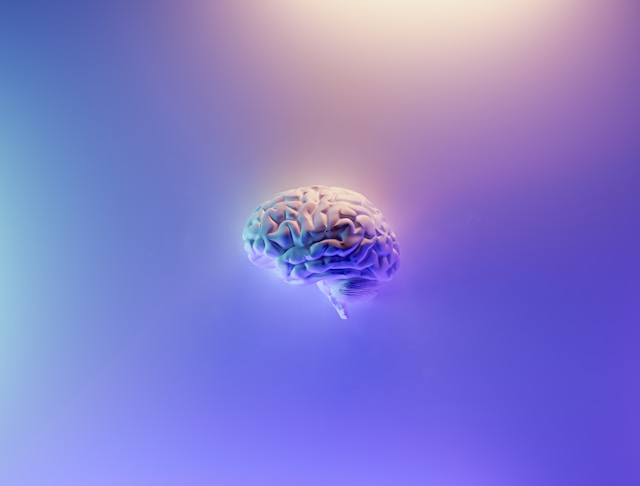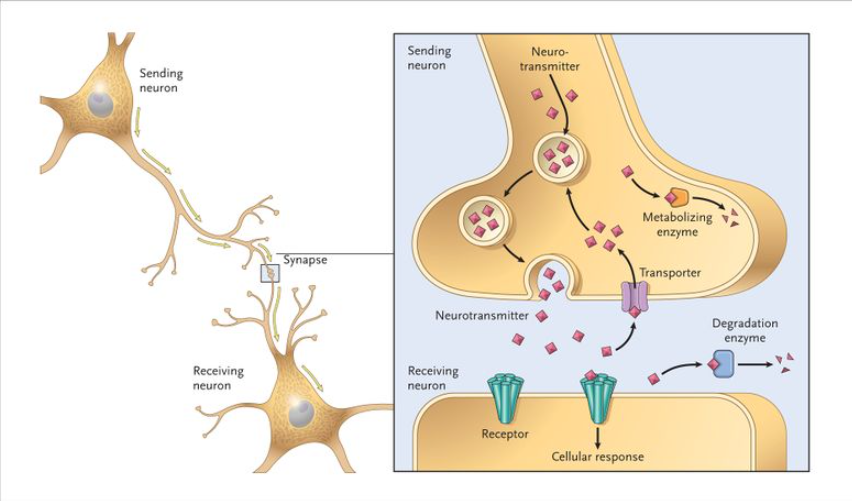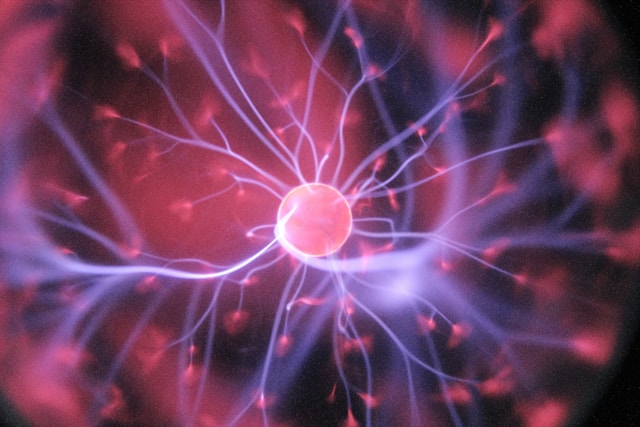Neurotransmitters
Life begins and ends at the cellular level.
It is estimated your brain houses at least 86 billion neurons. Brain cells communicate by passing chemical impulses via the gap between cells [synapse]. The chemical messages are unique molecules called neurotransmitters.
Neurotransmitters are the chemical messengers in your body. Neurotransmitters zip impulses from one nerve cell across a space [synapse] to the next nerve, muscle, or gland cell. Think of agitated hornets buzzing about a hive.
These messages help you move your limbs, feel sensations, sustain your heartbeat, and accept and respond to all the information your body receives from internal organs and your environment.
There are several neurotransmitter types in the brain. Neurotransmitters are also produced in the stomach lining. Neurotransmitters generated outside the brain cannot cross the blood-brain barrier unless it is a neurotransmitter precursor – B vitamins and tryptophan, for example. Neurotransmitters are endogenous.
Your nervous system controls everything from your mind, muscles, and organ functions. It represents a vast network that sends and receives electrical impulses from nerve cells to target cells.
Your nerve cells send and receive information from all body sources. This constant feedback is essential to your body’s optimal function.
Your nervous system controls numerous functions – find a few below:
→ Heartbeat;
→ Blood pressure;
→ Breathing;
→ Muscle movements;
→ Thoughts;
→ Cognition;
→ Feelings;
→ Sleep;
→ Healing;
→ Pace of aging;
→ Stress response;
→ Hormone regulation;
→ Digestion;
→ Satiety;
→ Sensory perception

TERMINOLOGY
Synapse → The transmission site of electric nerve impulses between two nerve cells [neurons] or between a neuron and a gland or muscle cell [effector]. A synaptic connection between a neuron and a muscle cell is called a neuromuscular junction.
The site of impulse transmission between presynaptic [axons] and postsynaptic [dendrites].
Synaptic gap → The space or cleft between neurons at the synapse in which nerve impulses are transmitted. The gap between neurons before the binding of pre-and postsynaptic neurons.The space between the axon of one neuron and the dendrite of another neuron.
Synaptic vesicles → Miniscule electron-lucent sacs clustered at the presynaptic locations. Synaptic vesicles store neurotransmitters later released in the synapse by a voltage-dependent calcium channel. Vesicles are essential for propagating nerve impulses between neurons and continual cellular regeneration.
This communication process is termed neurotransmission. Neurotransmitters transmit signals from nerve cells to target cells. These target cells may be in muscles, glands, or other nerves.
Neurotransmission → Neurotransmission is the process by which signaling molecules called neurotransmitters are released by the axon terminal of a neuron and then bind to and react with the receptors on the dendrites of another neuron.
Neurotransmitters are endogenous [produced inside the neuron]. Neurotransmitters represent the keys to communication between your brain and body. Neurotransmitters allow nerve cells to communicate.

THE BRAIN
The cerebral cortex is the most developed and largest part. It controls thinking, perception, and language comprehension.
The cerebral cortex is the outer layer of your brain’s surface on top of the cerebrum. The cerebral cortex performs essential functions like memory, thinking, learning, reasoning, problem-solving, emotions, consciousness, and sensory functions.
The corpus callosum connects the left and right hemispheres of the cerebral cortex.
One-half of the cerebrum controls muscle functions, speech, thought, emotions, reading, writing, and learning.
Hemispheres
Left Hemisphere → Controls the right side of the body. It regulates language, mathematical prowess, problem-solving, and decisions.
Right Hemisphere → Controls the left side of the body. It is responsible for creativity, and spatial relationship comprehension.
Cerebral Cortex Lobes
→ Parietal Lobe
Located below the crown of the head;
Processes sensory information – pain, touch, pressure
→ Frontal Lobe
Located behind the forehead;
Regulates the initiation and coordination of motor skills and cognitive skills
→ Temporal Lobe
Located above the ears and behind the temple;
Processes information you hear;
Integrates sensory information
→ Occipital Lobe
Located against the skull in the back of the brain;
Processes visual information
Hypothalamus
The hypothalamus is a gland that regulates your endocrine [hormonal] system – like a thermostat. It controls temperature, heart rate, hunger, satiety, blood pressure, sex drive, sleep, and moods.
The hypothalamus receives impulses from your brain and endocrine system. It sends signals [hormones] to a specific part of your brain called the pituitary gland.
Your pituitary gland is often termed your “master gland.” It creates, stores, and releases hormones to your endocrine system – thyroid, adrenal glands, kidneys, reproductive organs, bones, and muscles.
Your endocrine system controls several functions of your body:
→ Body temperature;
→ Electrolyte balance;
→ Regeneration;
→ Heart rate;
→ Blood pressure;
→ Digestion;
→ Respiration;
→ Fatigue;
→ Arousal
Cerebellum
The cerebellum is the compact portion of your brain located in the back of the head between the cerebrum and the brain stem.
It controls complex motor functions such as spatial awareness or kinesthesia, posture, movement, and balance.
The key to spatial awareness is proprioception.

Brain Stem
It is considered the most primitive portion of your brain. The brain stem is a stalk-like part that connects the cerebrum with the spinal cord. It regulates heart rate and breath rates.
The brain stem regulates simple reflexes such as sneezing, coughing, and digestion in addition to the CNS and sleep cycle.
Find below the two primary parts:
→ Pons
Regulates unconscious processes and functions – especially the sleep-wake cycle and breathing. It fuses the cerebral cortex with the cerebellum and spinal cord – pons transport neurons to the face and neck regions from junction points.
Pons control motor functions, eye movement, sensations, hearing, taste, and more.
→ Medulla
It is located at the base of your brain and connects the brain to the spinal cord. It plays a major role in regulating the cardiovascular and respiratory systems. Regulates heart rate, respiration, and blood pressure.
The medulla controls reflexive actions – coughing, sneezing, swallowing, and vomiting. The medulla is a vital conduit for nerve signals throughout your body.
Limbic System
This system represents the part of your brain involved in behavioral and emotional responses such as reproduction, eating, drinking, emotional well-being, and survival instincts – the sympathetic and parasympathetic prongs of the ANS [autonomic nervous system].
→ Hippocampus
Controls learning and memory. The hippocampus is a complex brain structure embedded deep in the temporal lobe. It has a major role in learning and memory. It is a vulnerable structure often damaged by various stimuli. Studies have shown that it is affected by a variety of neurological and psychiatric disorders.
→ Amygdala
The key player related to emotional behavior. The main job of the amygdala is to regulate emotions – fear and aggression, reward processing, and decision-making. The amygdala and the limbic system are the parts of your brain that detect danger.

NEUROTRANSMISSION
There are billions of nerve cells in your body. Think of a neuron as a tree.
A neuron has three main parts:
→ Cell body or soma [trunk];
The cell body is vital to producing neurotransmitters and maintaining the function of the nerve cell. It is the nucleus.
→ Axons [roots];
The axons [presynaptic] send electrical signals along the nerve cell to the axon terminal. Axons send messages to the axon terminal for transport to the dendrites. The myelin sheath covers and protects axons while enhancing the transmission speed of impulses.
→ Axon terminal
An axon terminal is a specialized region at the end of an axon that contains finger-like projections. It is responsible for releasing neurotransmitters to other nerves or effector cells. Axon terminals represent hubs or temporary storage facilities for neurotransmitters in transit.
Axon terminals are the parts of a nerve cell that make synaptic connections with another nerve cell or with an effector cell [muscles or glands].
This is where the electrical message is changed to a chemical signal using neurotransmitters to communicate with the next group of nerve cells, muscle cells, or organs.
→ Dendrites [branches]
The dendrites [postsynaptic] receive messages from neurons.

Neurotransmission is the transfer of information between neurons.
Find below a simplified version of the intricate process:
→ An impulse travels through the cell body to the axon;
→ Neurotransmitters are released from the axon terminal into the synapse;
→ Neurotransmitters cross the synapse to specific dendrite neurons [receptors];
→ Neurotransmitters and receptors merge analogous to keys opening locks;
→ Neurotransmitters are released from the receptors;
→ Neurotransmitters must be cleared from the synaptic cleft once the message is delivered.
This occurs in one of the following processes:
→ Fade away [diffusion];
→ Repurposed by the nerve cell that released it [reuptake];
→ Enzymatic breakdown within the synapse to prevent receptor cell binding [degradation]
The brain requires neurotransmitters to regulate several necessary functions via chemical synaptic transmission including:
→ Heart rate;
→ Breathing;
→ Sleep cycles;
→ Digestion;
→ Mood;
→ Concentration;
→ Appetite; and
→ Muscle movements
Chemical synaptic transmission → a process that allows information to be passed between nerve cells, or between a neuron and a target cell, via the release of chemical messengers [neurotransmitters]. Chemical synapses are the most common type of synapse in the body.
The pre-and postsynaptic events are highly regulated and subject to use-dependent changes that are the basis for plasticity and learning in the central nervous system [CNS].

NEUROTRANSMITTER TYPES
Scientists know of at least 100 neurotransmitters and suspect many others have yet to be discovered. They can be grouped into types based on their chemical nature.
Some of the best-known neurotransmitter examples and their functions include the following:
→ Amino Acids [GABA, Glutamate];
→ Peptides [Endorphins, Oxytocin];
→ Monoamines [Dopamine, Adrenalin, Serotonin, Histamine, Norepinephrine];
→ Purines [Adenosine triphosphate, Adenosine];
→ Gasotransmitters [Carbon monoxide, Nitric oxide];
→ Acetylcholine [ACh]
Amino acids neurotransmitters
These neurotransmitters are involved in most functions of your nervous system.
→ Glutamate
This is the most common excitatory neurotransmitter of your nervous system. It is the most abundant neurotransmitter in your brain. It plays a key role in cognitive functions like thinking, learning, and memory. Imbalances in glutamate levels are associated with Alzheimer’s disease, Parkinson’s disease, and seizures.
→ Gamma-aminobutyric acid [GABA]
GABA is the predominant inhibitory neurotransmitter of your nervous system – particularly in your brain. It regulates brain activity to prevent problems in the areas of anxiety, irritability, concentration, sleep, seizures, and depression.
→ Glycine
Glycine is the most common inhibitory neurotransmitter in your spinal cord. Glycine is involved in controlling hearing processing, pain transmission, and metabolism.
Monoamines neurotransmitters
They are derived from aromatic amino acids like tryptophan, tyrosine, and phenylalanine through the action of aromatic amino acid decarboxylase enzymes. Monoamine oxidases in the body deactivate monoamines by removing the amine group.
Monoamine neurotransmitters include:
→ Catecholamines: Dopamine [DA], norepinephrine [NE], and epinephrine [EP];
→ Indolamines: Serotonin [5-HT];
→ Imidazolamines: Histamine [HA]
Monoamine neurotransmitters regulate emotions, arousal, memory, mood, self-control, motivation, drive, and cognition. These neurotransmitters perform various roles in your nervous system and your brain.
Many nervous system disorders involve abnormalities of monoamine neurotransmitters and common prescription drugs may impact neurotransmitters.
→ Serotonin
Serotonin is an inhibitory neurotransmitter. Serotonin helps regulate mood, sleep patterns, sexuality, anxiety, appetite, and pain. Diseases associated with serotonin imbalance include seasonal affective disorder, anxiety, depression, fibromyalgia, and chronic pain.
Medications that regulate serotonin and treat these disorders include selective serotonin reuptake inhibitors [SSRIs] and serotonin-norepinephrine reuptake inhibitors [SNRIs].
→ Histamine
Histamine regulates body functions including wakefulness, feeding behavior, and motivation. Histamine plays a role in asthma, bronchospasm, mucosal edema, and multiple sclerosis.
→ Dopamine
Dopamine [DA] plays a role in your body’s reward system, which includes feeling pleasure, achieving heightened arousal, and learning. Dopamine also helps focus, concentration, memory, sleep, mood, and motivation.
Diseases associated with dysfunctions of the dopamine system include Parkinson’s disease, schizophrenia, bipolar disorder, restless legs syndrome, and attention deficit hyperactivity disorder [ADHD].
Many highly addictive drugs [cocaine, methamphetamines, amphetamines] act directly on the dopamine system.
→ Epinephrine
Epinephrine [EP] is also called adrenaline. It [and noepinephrine] are responsible for your “fight-or-flight response” to fear and stress. Read more about the central nervous system [CNS].
These neurotransmitters stimulate your bodily responses by increasing your heart rate, breathing, blood pressure, blood sugar, and blood flow to your muscles and heighten focus on environmental stressors.
Excess epinephrine may lead to high blood pressure, diabetes, heart disease, and other health problems. Epinephrine is used to treat anaphylaxis, asthma attacks, cardiac arrest, and severe infections.
→ Norepinephrine
Norepinephrine [NE] is also called noradrenaline. It increases blood pressure and heart rate. It is known for its effects on alertness, arousal, decision-making, attention, and focus.
Medications often aim to increase norepinephrine levels to heighten focus and concentration to treat ADHD or to modulate norepinephrine to improve depression symptoms.

Peptide neurotransmitters
Peptides are polymers or chains of amino acids. It Is a compound consisting of two or more amino acids linked in a chain, the carboxyl group of each acid being joined to the amino group of the next by a bond of the type -OC-NH-.
The fundamental nature of peptides as the building blocks of proteins allows the synthetic and in vitro mimicking of endogenous substances to regulate specific cellular functions and facilitate biochemical processes in the body.
→ Endorphins
Endorphins represent the natural pain reliever in your body. They play a role in our perception of pain. The release of endorphins reduces pain and induces relaxation. Low levels of endorphins may play a role in fibromyalgia and headaches.
Acetylcholine
This excitatory neurotransmitter performs several functions in your CNS and peripheral nervous system [nerves that branch from the CNS].
Acetylcholine [Ach] regulates heart rate, blood pressure, and gut motility. It plays a crucial role in muscle contractions, memory, motivation, sexual desire, sleep, and learning. Neurons in your autonomic nervous system [ANS] discharge Ach.
Imbalanced acetylcholine levels are linked with health issues, including Alzheimer’s disease, seizures, and muscle spasms.
Additional Neurotransmitters
Neurochemicals such as oxytocin and vasopressin are classified as neurotransmitters. These gems are produced and released via the hypothalamus to work directly with neurons and have been linked to monogamous tendencies and drug addiction.
Hormones such as estrogen and testosterone possess the ability to function as neurotransmitters with influencing synaptic activity being the desired outcome.
Recognized neurotransmitter types include those relevant to how the brain responds to environmental and physiological stressors:
→ Corticotropin-releasing factor [CRF];
→ Dynorphin;
→ Neuropeptide Y
The following are classified as co-neurotransmitters thanks to being released and partnering with other neurotransmitters:
→ Galanin;
→ Enkephalin;
→ Neuropeptide Y
The complexity of neurotransmission highlights the ceaseless molecular needs of the brain to enhance its range of function, flexibility, and limitless potential.
Glial cells release neurotransmitters.
Glial cells [known as neuroglia or glia] are non-neuronal cells in the nervous system that support and protect neurons. They are termed the “glue” of the nervous system because they perform many activities to help the brain function normally.
For example, Glial cells release glutamate into synapses in the hippocampus to assist with signaling proficiency, and this has intensified our hunger to learn and understand the various molecules cell types release to impact human cognition, sensations, and behavior.
Astrocytes are star-shaped glial cells known to release a variety of neurotransmitters into the synapses to facilitate synaptic plasticity.
NEUROTRANSMITTER ACTIONS
Neurotransmitters transmit one of three possible actions via their messages:
→ Excitatory
Excitatory neurotransmitters blast neurons to the next cell. Examples of excitatory neurotransmitters include glutamate, epinephrine, and norepinephrine.
→ Inhibitory
Inhibitory neurotransmitters block neurons from reaching the next cell. GABA, glycine, and serotonin are examples of inhibitory neurotransmitters.
→ Modulatory
Modulatory neurotransmitters tweak how cells communicate at the synapse. They may impact a large number of neurons simultaneously.

Neurotransmitters and Health
Alterations in the levels of specific neurotransmitters have been observed in various neurological disorders. Some are listed below.
→ Alzheimer’s disease;
→ Parkinson’s disease;
→ Depression;
→ Anxiety disorders;
→ Schizophrenia;
→ Epilepsy
NEUROTRANSMITTERS AND ENDURANCE SPORTS PERFORMANCE
The primary function of neurotransmitters is to stimulate muscle contraction. The exception is when acetylcholine [an inhibitory neurotransmitter] is positioned at the parasympathetic endings of the vagus nerve. The heart muscle is inhibited via the cardiac plexus.
Neurotransmitters can play a role in endurance sports performance in several ways, including:
→ Mental fatigue
Brain neurotransmission can contribute to mental fatigue which can impair endurance performance. The noradrenergic neurotransmitter system can propel central fatigue while dopamine and adenosine operate in multiple brain regions.
→ Motor function
Dopamine is a key neurotransmitter in many aspects of motor function, including muscle tone, cardiovascular and renal function, and motor control in the striatum. It may be important for maintaining exercise efficiency in trained people.
→ Pain and pleasure
Endorphins can block pain and increase feelings of pleasure as exercise enhances endorphin levels. Endocannabinoid system neurotransmitters may contribute to the euphoric feeling after a strenuous workout.
→ Fatigue
Exercise can also stimulate glutamine synthesis, leading to decreased production of glutamate, an excitatory neurotransmitter that may cause fatigue in endurance athletes. Serotonin levels may also increase during prolonged exercise, which could contribute to perceptions of lethargy and central nervous system fatigue.
The transient receptor potential [TRP] proteins are a family of ion channels that act as cellular sensors and signal integrators. Several members of the TRP family are sensitive to changes in cellular redox status.
TRPs are a class of permeable ion channels found in numerous tissues and cell types. TRP channels are responsible for various sensory responses such as heat, cold, pain, stress, vision, and taste and can be activated by several stimuli.
When brain serotonin activity or TRP availability to the brain increases, fatigue from prolonged exercise occurs more quickly.
Brain dopamine synthesis appears to be a key factor in CNS fatigue. It is necessary for movement while increased dopaminergic activity enhances endurance performance.
Several neurotransmitters are released during exertion including endorphins, endocannabinoids, and dopamine. Exercise also promotes neuroplasticity and increases the oxygen supply to your brain.

Find below a few neurotransmitters impacted by endurance sports:
→ Endorphins;.
→ Dopamine;
→ Norepinephrine;
→ Serotonin;
→ Endocannabinoids
Nitric Oxide [NO] plays a pivotal role in regulating calcium availability and sensitivity within the skeletal muscle to maintain optimal contractile function, potentially enhancing twitch force, rate of force development, shortening velocity, and power.
NO modulates endothelial function to promote relaxation of vascular smooth muscle [VSM] and subsequent dilation to enhance blood flow and augment mechanisms contributing to skeletal muscle performance, hypertrophy, and strength adaptations.
NO is a unique neurotransmitter due to its gaseous state. It is synthesized from the amino acid L-arginine via enzymes termed nitric oxide syntheses [NOS]. It bypasses storage in synaptic vesicles to diffuse amid cell membranes and behaves as a retrograde neurotransmitter – influencing synaptic plasticity.
Its ability to modulate neural correspondence highlights its unique role in each prong of your intricate nervous system. When released inside the body NO quickly and easily penetrates cells, promoting optimal, physiological function.
NO is produced in your body via the following modes:
→ Secreted by the cells in the inner lining of your blood vessels [endothelium];
→ Converted by oral bacteria from your intake of nitrates via your diet;
→ Created by bacteria on our skin when exposed to adequate sunlight
Find below a few benefits of NO respective to life and sport:
→ Increased blood vessel dilation;
→ Increased oxygenation;
→ Enhanced glutathione system;
→ Increased blood flow;
→ Lower blood pressure;
→ Improved vascular function;
→ Cellular proliferation;
→ Improved glucose uptake;
→ Increased muscle velocity;
→ Enhanced mitochondrial biogenesis;
→ Improved sleep quality;
→ Enhanced cognition and memory
NO is responsible for delivering oxygen-rich blood to every cell, tissue, and organ system in the human body, it is now recognized by the scientific, medical, and athletic communities as a key, physiological performance variable.
Aerobic exercise enhances the expression of neuroplasticity biomarkers including brain-derived neurotrophic factor [BDNF], insulin-like growth factor 1[(IGF-1], and vascular endothelial growth factor [VEGF].
A comprehensive genetic test will identify epigenetic markers to tweak in the spirit of transcending your health, performance, and longevity in life and sport. We have the technology to eliminate guesswork.
The last thing you want is to be fit but unhealthy.
A limitless life is a choice…
Learn more about our products and services at Performance Medicine™.



